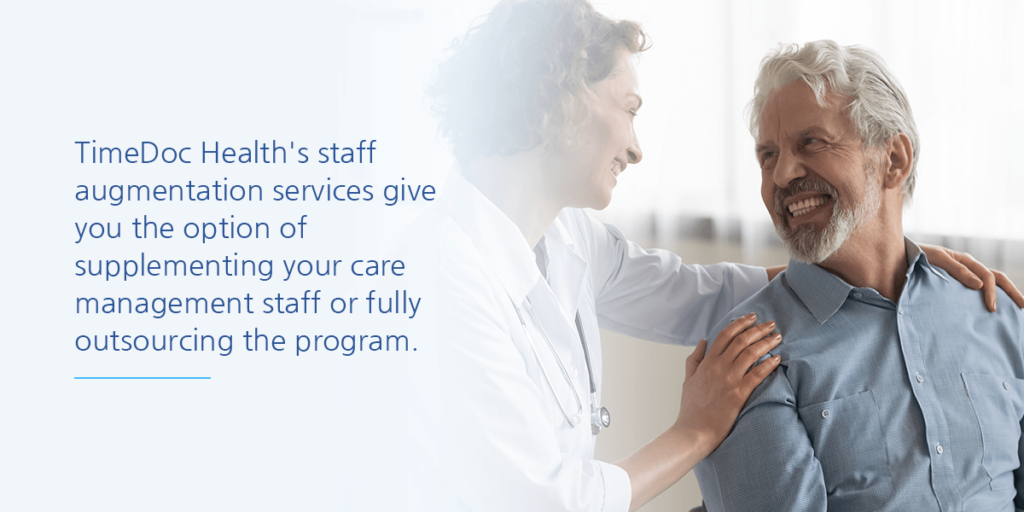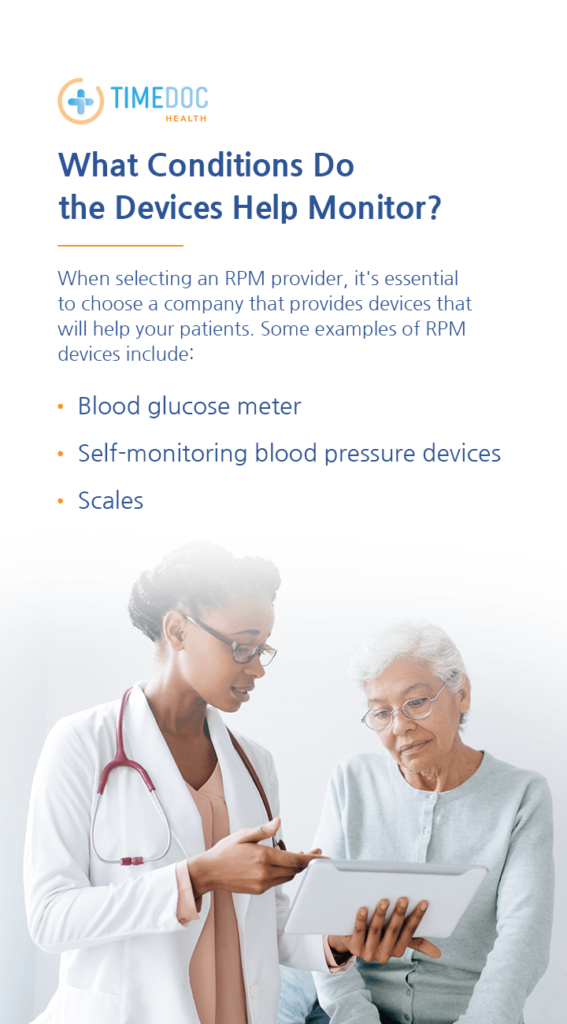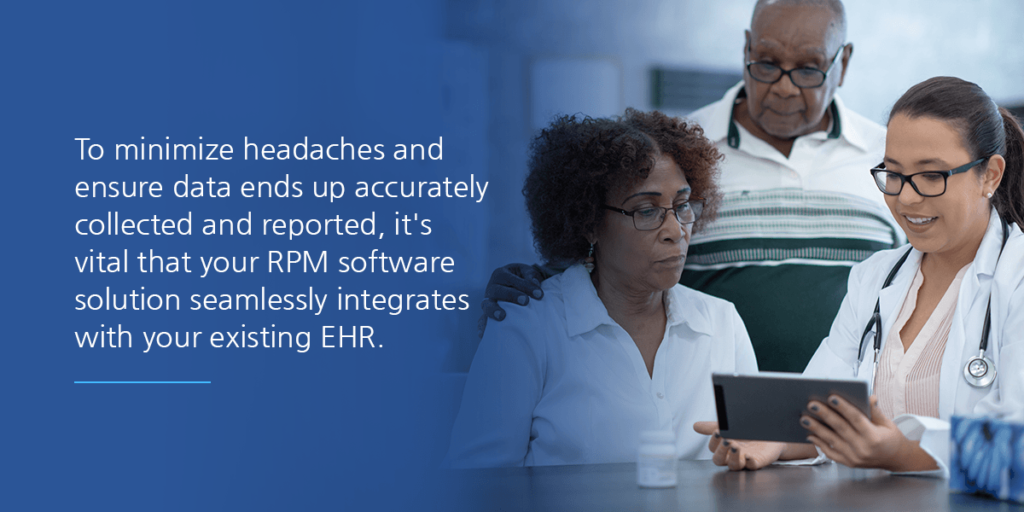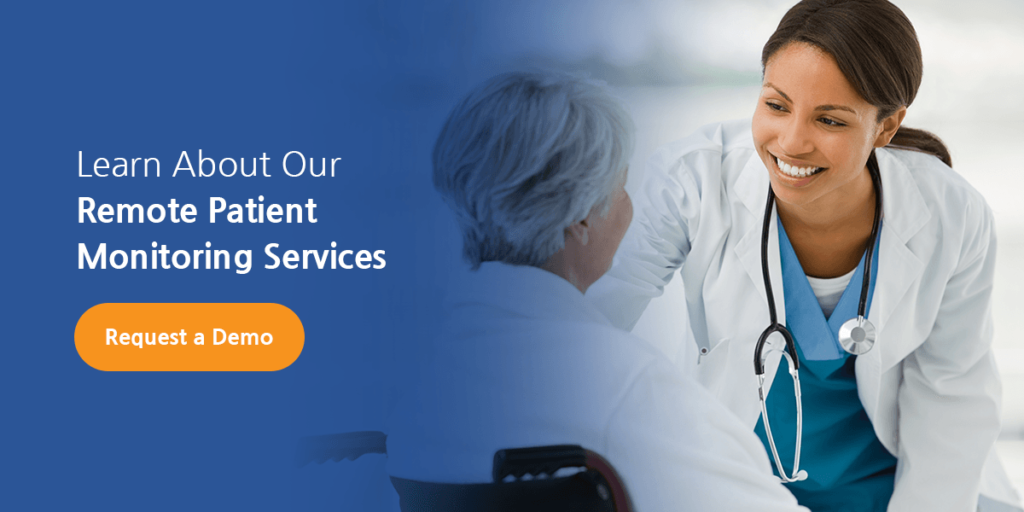Every day, clinicians diagnose patients with chronic conditions such as high blood pressure and diabetes and prescribe medications to help patients treat and manage those conditions. In many cases, simply prescribing medications isn’t enough. Plenty of patients have comorbidities that make treating chronic conditions more complex and require disease-specific treatment plans. Unfortunately, nothing can guarantee that a patient follows treatment protocol set forth by the physician and up until recently, providers did not have a way to track how patients were managing their conditions when they were away from the office.
A few years ago, the Centers for Medicare & Medicaid Services (CMS) launched new reimbursement codes to financially support providers in implementing remote patient monitoring (RPM) programs for their high-risk patients. RPM uses digital technology to keep tabs on patients while at home. There are two parts to this program:
1. Usage of FDA-approved devices that allow patients to measure their vitals in the comfort of their own homes. These devices collect data, such as blood glucose levels, blood pressure readings or weight, and transmit them directly to the patient’s healthcare provider.
2. Non-face-to-face monthly care coordination through a qualified health professional who reviews and interprets vitals, engages with the patient, and communicates necessary information to the primary care provider.
Similar to other care modalities introduced by CMS, healthcare organizations struggle with the people, process and technology needed to independently launch a successful RPM program. This has caused medical groups and community health centers to turn to RPM solutions providers to help fill their resource gaps.
RPM solution providers can step in and deliver the tools and software — and in some cases, care coordination services — a healthcare organization needs to provide its patients with the option of tracking their health, even when they aren’t in the office. Here’s what to look for in an RPM program and how to choose the best RPM company that your organization can partner with.
How Does Remote Patient Monitoring Software Work?
RPM devices include blood glucose monitors, blood pressure monitors and scales for weight management. While those devices can collect the data needed to track a patient’s condition or progress, they don’t deliver the results to your practice on their own. That’s where RPM software comes in — it captures the data collected by an RPM device, such as a blood sugar level or blood pressure reading.
RPM software integrates with your organization’s EHR system, so physicians can keep a record of the patients’ vitals inside their medical charts. The software can calculate an average of values over time and alert you to any measures outside of the accepted range. Using RPM devices and software, physicians can make adjustments to a patient’s treatment plan as needed, reducing hospital or emergency department utilization.
TimeDoc Health’s RPM solution helps with device management and makes it easy for providers to order devices when their patients enroll in their RPM program.

Why Outsource Care Coordination?
A healthcare organization’s providers must focus on delivering the best possible care for their practice’s patients. While care coordination certainly enhances patient care, it can be a challenge to launch and maintain such a program on your own. For instance, your practice might not have the staffing level needed to efficiently enroll patients in an RPM program or provide the necessary 20 minutes of engagement for each patient, every month.
As an alternative, outsourcing care coordination to a company that provides software solutions and RPM services can eliminate some of the obstacles involved in implementing an RPM program. TimeDoc Health’s staff augmentation services give you the option of supplementing your care management staff or fully outsourcing this part of the program. Therefore, you end up with a comprehensive and scalable solution that can evolve with your practice’s needs.
Evaluating Remote Patient Monitoring Companies
If you’re ready to hire a remote patient monitoring software and service provider, there are several factors to keep an eye out for when evaluating companies. Everything from the conditions the RPM devices monitor to the level of customer service offered by the vendor is essential to consider. Look for the following features as you make your decision:
1. What’s the RPM Device’s Connectivity?
The devices that RPM enrolled patients use must transmit data, such as blood pressure readings, blood glucose levels or weight, to the provider’s EHR. RPM devices can transmit data using one of two types of connectivity — some devices are Bluetooth-enabled and others are cellular-enabled.
Bluetooth-Enabled RPM Devices
Bluetooth uses a short-range wireless technology to send data. It transmits information over short distances using radio frequency. To use a Bluetooth-enabled device, a patient must have an internet connection. The devices also often require users to log in to a portal or download an app before data can be transmitted. Patients who don’t have internet service at home or aren’t tech-savvy can struggle to use them.
Cellular-Enabled RPM Devices
Alternatively, cellular-enabled RPM devices send data over the same network a smartphone or cell phone does. Just as a cell phone is ready to use the minute you turn it on, so are cellular-enabled RPM devices. There’s no complicated set-up process or need to search for a network to use. For that reason, many organizations prefer to work with cellular devices rather than Bluetooth-enabled devices.
Using the right cellular-enabled device can ensure data transmission, even in areas with limited cellular networks. Choosing devices with cellular connectivity is usually more cost-effective, patient-friendly and streamlined versus Bluetooth ones.

2. What Conditions Do the Devices Help Monitor?
RPM devices can track a range of chronic conditions, from heart disease to diabetes. When selecting an RPM provider, it’s essential to choose a company that provides devices that will help your patients. Some examples of RPM devices include:
- Blood glucose meter: Those with either Type 1 or Type 2 diabetes need to regularly track their blood sugar levels, as blood sugar monitoring plays a critical role in controlling diabetes. Using a blood glucose meter allows a patient and provider to see how their blood sugar levels fluctuate throughout the day and respond to various factors, such as meals or medications. It’s also important to understand how patients will get refills of lancelets and test strips. Many RPM partners do not include refills, leaving patients responsible for obtaining these costly supplies on their own.
- Self-monitoring blood pressure devices: Patients with hypertension can also benefit from tracking their blood pressure at home. Measuring with a blood pressure device can let patients and providers know if lifestyle changes or medications are helping control the condition. A device that connects to a patient’s chart allows for up-to-date readings and gives a provider the ability to track changes or improvements over time.
- Scales: Scales can benefit patients who need assistance with congestive heart failure or other conditions. These patients need to keep track of their weight, as weight gain is often one of the first signs the condition is worsening. RPM devices that measure weight can alert a provider when a patient gains a few pounds quickly, allowing the provider to take action to keep the condition from potentially worsening.
Ideally, the remote patient monitoring company will provide devices that align with the conditions your organization treats and will help your patients monitor their health at home.
3. Is the Data Accessible and Functional?
What does the RPM software do with the patient data? An RPM platform that gives providers the option of making diagnostic decisions or altering a patient’s treatment plan based on the data collected is likely to be more useful than an RPM program that merely collects data.
An alert system is one feature to look for when assessing the accessibility and robustness of the software’s data collection. If a patient’s vitals are outside the acceptable range, what happens? Ideally, the RPM platform will let your team customize alerts so the appropriate people are notified. In the best-case scenario, your team will be able to customize the alerts based on the needs of the patient and the condition you’re monitoring.
Another feature to look for is a patient dashboard. At a quick glance, you want to see the information gathered on your entire panel of patients. This way, your team can follow your entire patient population for reporting and other needs.
4. What Are the Operational Processes?
It’s worth considering how easy the RPM solution will be to set up and keep running. Some providers will offer support throughout the onboarding process and beyond, while others might offer much more limited assistance. One factor to ask about is whether the company will train your team on using and integrating the RPM software. If the company also offers care coordination services, it’s worth finding out how they’ll collaborate with your organization’s staff members.
As your practice changes, your RPM needs will likely change, too. For example, patients might leave the practice or your organization might merge with another one, changing the size of your patient population. When evaluating providers, consider how complicated it is to enroll or remove patients from the program. If your practice grows, will the service level the RPM provider gives you expand alongside it?

5. How Does the RPM Program Integrate With Your EHR?
Unless you’re building a practice entirely from the ground up, you most likely already have an electronic health record (EHR) in place. To minimize headaches and ensure data ends up accurately collected and reported, it’s vital that your RPM software solution seamlessly integrates with your existing EHR. An RPM software company should make it easy to integrate your EHR with the RPM platform.
When evaluating remote patient monitoring vendors, ask about past EHR integrations and the systems that their vendor’s platform has paired with in the past. It’s also smart to find out how quickly the RPM provider is able to integrate with an EHR. Will the connection happen instantly or will there be lag time?
Consider what happens when patients measure their vitals using an RPM device. Where does the information end up? Ideally, it’ll auto-populate in their chart so your providers can quickly access that information when they want to track a patient’s condition and well-being.
Having an RPM solution that integrates with your current EHR is ideal. If you also use chronic care management or behavioral health integration, or plan to use either in the future, it’s worth evaluating how well the RPM solution and your EHR will integrate with those initiatives, too.
6. What Are the Overhead Costs and Fees?
Working with an RPM vendor can save your healthcare organization money in the long run as you enjoy lower staffing requirements and increased efficiency. RPM can also help you provide better care to patients, reducing overall healthcare costs.
However, the solutions aren’t available for free, meaning it’s up to you to evaluate the costs associated with each company. Therefore, two of the most important points to consider when examining fees and other costs are:
- Does the company charge a per-patient fee?: It can be cost-effective to choose a vendor that lets you enroll an unlimited number of patients in an RPM program. If the fee is on a per-patient basis, there’s a risk that the solution will become too expensive for your organization as the size of your patient population grows.
- Is the fee available on a per-year or per-month basis?: Another factor to consider is how frequently you need to pay for service. A per-month option can cost more in the long run but also allows your organization to incorporate the cost of the service into a monthly budget.
7. How Strong Are the Security and Compliance Features?
Participation in an RPM program requires a lot of trust on the part of the patient and provider. After all, your organization is asking patients to transmit sensitive health data, such as their weight or blood pressure readings, over a cellular or Bluetooth connection. These individuals need to have the reassurance that their data won’t fall into the hands of bad actors.
Both the devices provided and the software used by an RPM vendor should comply with privacy laws such as HIPAA and HITECH. Ask the company to explain the security measures it uses to keep patient data safe and its security breach action plans and regulations.
8. Are There Training and Support Measures?
An RPM solution provider should be there for your organization every step of the way, from configuration and launch through daily use of the program. When evaluating providers, find out what the process is for troubleshooting problems and if you’ll have a point of contact to guide you through using the software and accessing the services offered.
In an ideal situation, the provider will assign a client success manager to your organization. They’ll be there for you through onboarding and training and can provide support and assistance with troubleshooting.
What’s the Best Remote Patient Monitoring Company for Your Organization?
As a whole, your organization needs a secure, cost-effective and functional RPM solution. This program should be user-friendly and accessible for every patient who’s a part of your practice. Be sure to keep these points in mind when searching for an RPM partner and aim to work with a vendor that makes it easy to launch and maintain an RPM program. As a result, your RPM software will ultimately increase your ability to care for your patients’ health.
Learn About Our Remote Patient Monitoring Services
TimeDoc Health delivers an RPM solution that includes FDA-approved devices, software that easily integrates with your EHR and highly qualified staff for support. If you’re exploring remote patient monitoring vendors for your healthcare organization, TimeDoc Health is an effective RPM partner that can deliver the services you and your patients need. To learn more about our RPM program and schedule a demo, please call 1.844.784.8362, email us at info@timedochealth.com or fill out the form on our website.
Request a Demo
Please complete this form, and we’ll be in touch soon, or call us at 1.844.784.8362 to speak with a representative.


